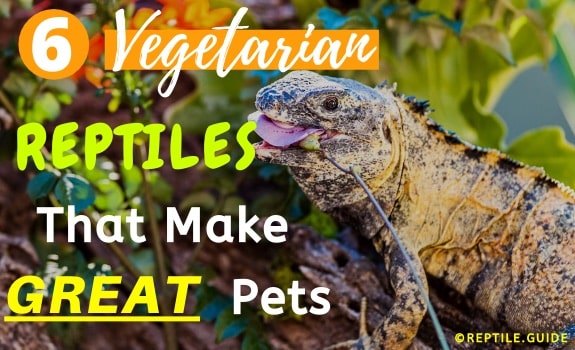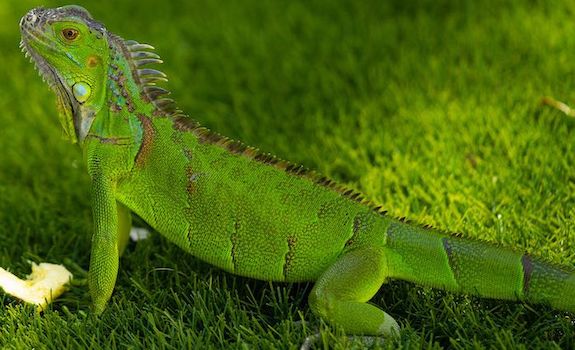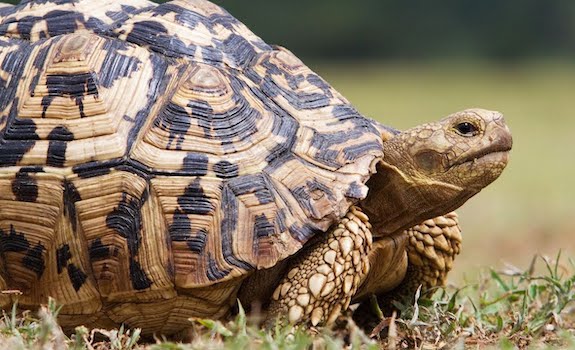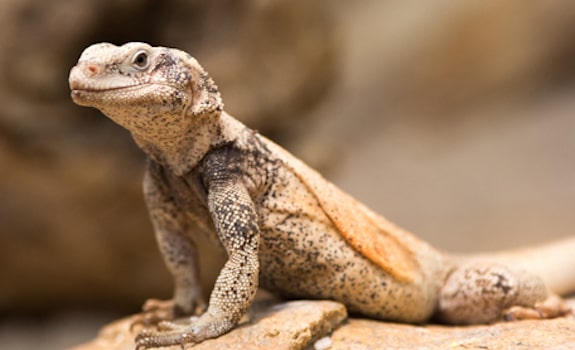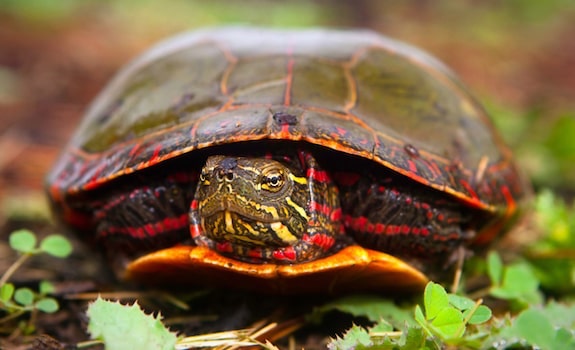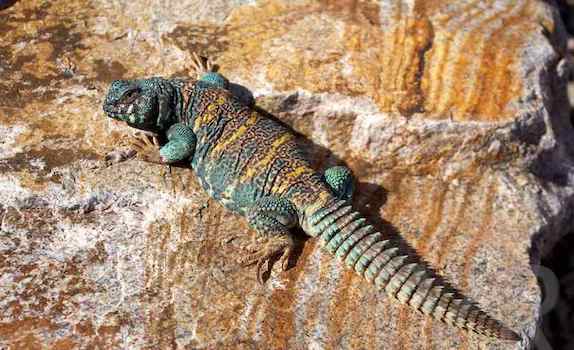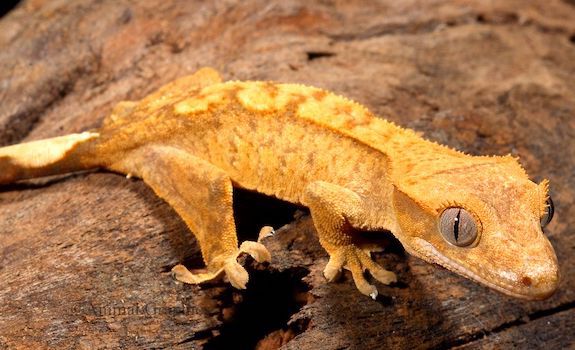Are you interested in getting a lizard but get the heebie-jeebies at the thought of feeding live mice or keeping insects in your house? If so, rest assured… you’re NOT alone!
It isn’t uncommon for first time lizard owners to feel some type of way about having to feed live insects or mice to their pets.
Fortunately, if you fall into this category, rest assured that it is possible to avoid this and still own a lizard . You’ll just have to pick the RIGHT lizard for you.
You see, not all lizards need to be fed a strictly carnivorous diet. Some lizards are largely herbaceous, meaning they eat mostly green plants, but they will need some sort of protein.
In fact, the vegetarian lizards below are prime examples of this because they either:
A) Eat a 100% plant-based diet
or
B) Require very little animal or insect-based protein
So, if you have your heart set on adopting and caring for a vegetarian reptile, simply keep reading!
In This Article
Vegetarian Lizard Recommendation #1: Green Iguana
Ah, the green iguana. What reptile lover hasn’t considered a green iguana at some point? This herbivore reptile loves his leafy greens.
The iguana’s main diet should consist of vegetation like:
- collard greens
- clover
- alfalfa
- escarole
- bok choy
- dark green lettuces
- mustard greens
- dandelion greens
- turnip greens
- kale
Dark green plant matter should make up about 80 to 90 percent of an iguana’s diet with 10 to 20 percent coming from starchy fruit and vegetables like squash, sweet potato, peaches, tomatoes, and bananas.
Some veterinarians recommend supplementing with a commercial iguana food, but others prefer to see these herbivore reptile pets eating a strictly fresh diet.
Whatever choice you make, bugs and mice won’t be something you have to deal with!
Vegetarian Lizard Recommendation #2: Dryland Tortoise
It’s easy to come up with an image of a tortoise lazily chewing a large leafy green. This is because vegetation makes up their diet and they are constantly eating to fuel themselves … even if they don’t seem to move fast enough to need much fuel.
Tortoises come in a variety of types and sizes with the giant tortoises of the Galapagos Islands being easily recognizable for their five-foot length and 550-pound weight!
The average homemaker is NOT going to keep a giant tortoise in their backyard though, so thankfully there are many smaller versions available as pets.
The Russian tortoise is a pretty common herbivore reptile to keep as a pet. It’s one of the smaller ones, weighing up to three pounds and only growing to about seven inches. This makes it super easy to house and feed.
You won’t go broke buying bales of hay for this little guy, although it may seem like it because these tortoises eat a lot of greenery for their size!
⭐️Fun Fact: It’s common knowledge that tortoises aren’t exactly speedsters, but how slow exactly are they? Well, on average you can expect tortoises to reach top speeds of about 1 mile per hour.
If you keep them in an outdoor habitat they will happily eat weeds in addition to whatever food you give them. Just be sure to keep any weeds or vegetation pesticide free!
If you want to get a medium-sized tortoise you might consider the leopard tortoise.
These weigh up to 80 pounds and are considered an intermediate tortoise for reptile keepers because they are susceptible to respiratory problems if their habitat is not ideal. However, they are very lovely to watch.
Keep in mind that these vegetarian reptiles can live up to 100 years in the wild, so you may be bequeathing your pet to a loved one.
Vegetarian Lizard Recommendation #4: Chuckwalla
Chuck what?!
The chuckwalla may very well be a herbivore reptile you’ve never heard of before.
Despite it’s fun (and slightly strange) name, the chuckwalla is just a large-sized lizard.
When you look at a picture, you might think… isn’t that an iguana? You wouldn’t be far off.
The Chuckwalla is in the Iguanidae species but is not quite like the more familiar green iguana.
The chuckwalla looks a bit like the older, more weathered, version of the iguana. It’s about the same size, but wider with saggy skin, a potbelly, and gray, drab color tones.
It’s meant to blend into rocks and dry desert landscape rather than the green, arboreal habitat of the green iguana.
Nevertheless, it is a fascinating lizard and should be considered by those that are a bit more experienced when it comes to caring for reptiles.
The chuckwalla lives to be around 20 years old and eats a strictly vegetarian diet.
In the wild, it loves desert flowers and fruit and any new plant growth. In captivity, its wild diet is mimicked with an assortment of leafy greens and vegetables.
Like the green iguana, the chuckwalla needs a spacious habitat, warm environment and basking spot.
Vegetarian Lizard Recommendation #3: Aquatic Turtle
A turtle is pretty much a tortoise that lives in the water, so the name “aquatic turtle” here is a bit redundant but it helps make a distinction between habitats.
Much like their landlubbing cousins, the turtle is one of the vegetarian reptiles and eats a largely plant-based diet. However, most turtles are omnivores with a much higher need for protein when they are young.
As they grow older they need significantly less protein. Naturally, the work around for this is to adopt a mature turtle who doesn’t have as high protein needs.
He will still need to be fed red worms, earth worms, and crickets though. These can be purchased freeze-dried and are fed similarly to any dried pellets or supplements that are given to them on land.
⭐️Fun Fact: You probably already know that turtles swim and tortoises don’t… but can you name any of the other 4 key differences between the two? The differences may surprise you…
One type of turtle that eats a reduced protein diet as it ages is the painted turtle. These turtles are known for their bright colors and easy nature.
They do not get very big and are often the first choice for a pet turtle with new turtle owners. They live to be about 25 to 30 years old and will need about 30 percent protein after they reach maturity.
Vegetarian Lizard Recommendation #5: Uromastyx
The Uromastyx is another lizard that you may have never heard of before. They are often called the spiny tail or the spiny-tailed agamid.
They are hefty, hardy lizards with different morphs that include green and yellow stripes.
They have very spiky tails. When they hide, they usually hide their bodies but let their spiky tail stick out.
They can live anywhere from 15 to 35 years. In the wild they live in incredibly dry, harsh conditions, which makes them one of the more durable reptiles you can own.
These vegetarian lizards are pretty easy to handle, similar to a bearded dragon. They love to be warm, warmer than most lizards, with UV bulbs.
Best of all, they are largely herbivorous, eating a wide variety of mustard greens and collard greens.
They also like seeds, like lentils and bird seed. Some uromastyx will eat an insect every now and then if you offer them, but they do NOT eat a heavy protein diet and can eat plenty of seeds, which will help them meet their protein requirements.
Some people even opt to use seeds like millet as the substrate in their habitat.
Uromastyx love hiding and nestling into corners. They do not climb as much as other lizards, but instead will dig and wedge themselves into corners.
Many of them are quite social and after they get used to handling and look forward to interacting with their owners.
One of the downsides of the uromastyx is that they aren’t as common as other reptiles, which can make them harder to find and often quite expensive.
Vegetarian Lizard Recommendation #6: Solomon Island Skink
The Solomon Island Skink (AKA Monkey-Tailed Skink, Prehensile-Tailed Skink, and Zebra Skink) is definitely a fan-favorite amongst lizard lovers.
The skink is a unique creature on its own. They don’t exactly look like other lizards, and some people think they have frog-like features but they are definitely NOT an amphibian.
The Solomon Skink is even more unique because they eat a largely plant-based diet.
Other skinks, especially the most common garden skink, love eating an omnivore diet. Those vegetarian reptiles will eat slaters, moths, crickets, earthworms, vertebrates, and pretty much anything that moves and will fit in its mouth!
On the other hand, the Solomon Island Skink NEEDS to eat:
- 60-70 percent leafy greens
- 20-30 percent other vegetables
- Optional 10 percent fruit
Pothos leaves are a favorite of skinks and can be grown in the home. They may eat an occasional egg, but this is not necessary. Adult skinks should be fed every other day, while baby skinks should be fed daily.
This is the largest skink in the world so it needs a good-sized enclosure.
One thing to note is that if you think that this skink is going to be mild-mannered and easy to handle, given it’s a herbivore reptile, you would be mistaken. Or, at least, you could be mistaken…
The Solomon Island Skink has a wide range of personalities. If your skink does take offense to your existence or actions, he can deliver a surprisingly damaging bite for a creature not designed to consume flesh.
Their jaw bites will draw blood, but they do show signs of agitation and get puffed up BEFORE they bite.
The Solomon Island Skink gets its names from its prehensile tail, which it uses as a fifth limb to climb. This is fascinating to watch and means that this skink will LOVE a habitat where it can use its tail and climb.
Vegetarian Lizard Recommendation BONUS: Crested Gecko
The crested gecko does not eat a herbivore diet. However, if you are interested in avoiding feeding live animals, live insects or even freeze-dried food, you may want to consider the crested gecko.
Why? Well, because they eat a commercial food that turns into a mush and can be left in their habitat for about 24 hours.
These vegetarian reptiles can be offered fruit occasionally and, if you are willing, some crested geckos will accept live insects in their diet.
Another major pro? Crested geckos are pretty easy to keep. Furthermore, they are not very big so they do not need a huge habitat,
However, they are fussy about the parameters of their habitat. As such, you will need to do something to maintain the geckos every day.
They need a light misting – but not too wet – and they need a warm temperature – but not too hot.
They are somewhat fragile and can lose their tails if they get scared. In fact, most crested geckos in the wild will lose their tail by adulthood.
In captivity, they need to be very pampered in order to keep their tails, but often lose them anyway.
These vegetarian lizards come in a huge variety of colors and don’t have any kind of common pattern that is typical of the crested gecko. They can be solid, or patterned, and can be almost any color you can imagine.
Wrapping Up Herbivore Reptiles
It’s an image often seen in movies and on TV. Someone is holding a live mouse by its tail and slowly lowers it down to a lizard with a slightly sadistic look on his face.
In some ways, this is a reproduction of natural life as most lizards hunt and catch prey in the wild. But there is something inequitable about putting live mice (or insects!) into a terrarium with no option of escape.
Sure, some of us are able to stomach it easier than others. But, if you find yourself uncomfortable with this concept, rest assured there are options available to you that minimize your exposure to mice and bugs.
Naturally there could be a few reasons why you may want to avoid dealing with feeding insects or vertebrates…
Perhaps it makes you squeamish or someone else in your household uncomfortable. Perhaps you like the idea of rescuing feeder fish and rodents instead of sending them to their deaths. Or you just think it might be too much work.
Whatever the reason, if you choose to still adopt a reptile make sure you do adequate research. This will ensure you don’t end up causing harm to a reptile by not providing for its biological needs.
